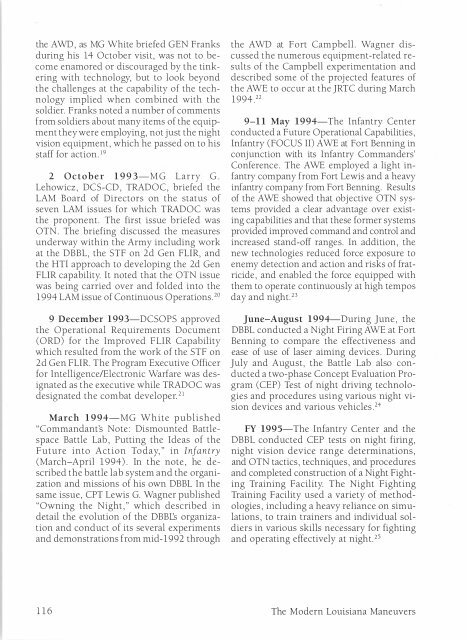The Modern Louisiana Maneuvers - US Army Center Of Military History
The Modern Louisiana Maneuvers - US Army Center Of Military History
The Modern Louisiana Maneuvers - US Army Center Of Military History
Create successful ePaper yourself
Turn your PDF publications into a flip-book with our unique Google optimized e-Paper software.
the AWD , as MG White briefed GEN Franks<br />
during his 14 October visit, was not to become<br />
enamored or discouraged by the tinkering<br />
with technology, but to look beyond<br />
the challenges at the capability of the technology<br />
implied when combined with the<br />
soldier. Franks noted a number of comments<br />
from soldiers about many items of the equipment<br />
they were employing, not just the night<br />
vision equipment, which he passed on to his<br />
staff for action. 19<br />
2 October 1993-MG Larry G.<br />
Lehowicz, DCS-CD , TRADOC, briefed the<br />
LAM Board of Directors on the status of<br />
seven LAM issues for which TRADOC was<br />
the proponent. <strong>The</strong> first issue briefed was<br />
OTN. <strong>The</strong> briefing discussed the measures<br />
underway within the <strong>Army</strong> including work<br />
at the DBBL, the STF on 2d Gen FUR, and<br />
the HTI approach to developing the 2d Gen<br />
FUR capability. It noted that the OTN issue<br />
was being carried over and folded into the<br />
1994 LAM issue of Continuous Operations. 20<br />
9 December 1993-DCSOPS approved<br />
the Operational Requirements Document<br />
(ORD) for the Improved FUR Capability<br />
which resulted from the work of the STF on<br />
2d Gen FUR. <strong>The</strong> Program Executive <strong>Of</strong>ficer<br />
for Intelligence/Electronic Warfare was designated<br />
as the executive while TRADOC was<br />
deSignated the combat developer 21<br />
March 1994-MG White published<br />
"Commandant's Note: Dismounted Battlespace<br />
Battle Lab, Putting the Ideas of the<br />
Future into Action To day," in Infantry<br />
(March-April 1994). In the note, he described<br />
the battle lab system and the organization<br />
and missions of his own DBBL In the<br />
same issue, CPT Lewis G. Wagner published<br />
"Owning the Night," which described in<br />
detail the evolution of the DBBl's organization<br />
and conduct of its several experiments<br />
and demonstrations from mid-1992 through<br />
116<br />
the AWD at Fort Campbell. Wagner discussed<br />
the numerous equipment-related results<br />
of the Campbell experimentation and<br />
described some of the proj ected features of<br />
the AWE to occur at the JRTC during March<br />
1994 22<br />
9-11 May 1994-<strong>The</strong> Infantry <strong>Center</strong><br />
conducted a Future Operational Capabilities,<br />
Infantry (FOC<strong>US</strong> II) AWE at Fort Benning in<br />
conjunction with its Infantry Commanders'<br />
Conference. <strong>The</strong> AWE employed a light infantry<br />
company from Fort Lewis and a heavy<br />
infantry company from Fort Benning. Results<br />
of the AWE showed that objective OTN systems<br />
provided a clear advantage over existing<br />
capabilities and that these former systems<br />
provided improved command and control and<br />
increased stand-off ranges. In addition, the<br />
new technologies reduced force exposure to<br />
enemy detection and action and risks of fratricide,<br />
and enabled the force equipped with<br />
them to operate continuously at high tempos<br />
day and night. 23<br />
June-August 1994-During June, the<br />
DBBL conducted a Night Firing AWE at Fort<br />
Benning to compare the effectiveness and<br />
ease of use of laser aiming devices. During<br />
July and August, the Battle Lab also conducted<br />
a two-phase Concept Evaluation Program<br />
(CEP) Test of night driving technologies<br />
and procedures using various night vision<br />
devices and various vehicles H<br />
FY 1995-<strong>The</strong> Infantry <strong>Center</strong> and the<br />
DBBL conducted CEP tests on night firing,<br />
night vision device range determinations,<br />
and OTN tactics, techniques, and procedures<br />
and completed construction of a Night Fighting<br />
Training FaCility. <strong>The</strong> Night Fighting<br />
Training FaCility used a variety of methodologies,<br />
including a heavy reliance on simulations,<br />
to train trainers and individual soldiers<br />
in various skills necessary for fighting<br />
and operating effectively at night. 25<br />
<strong>The</strong> <strong>Modern</strong> <strong>Louisiana</strong> <strong>Maneuvers</strong>
















